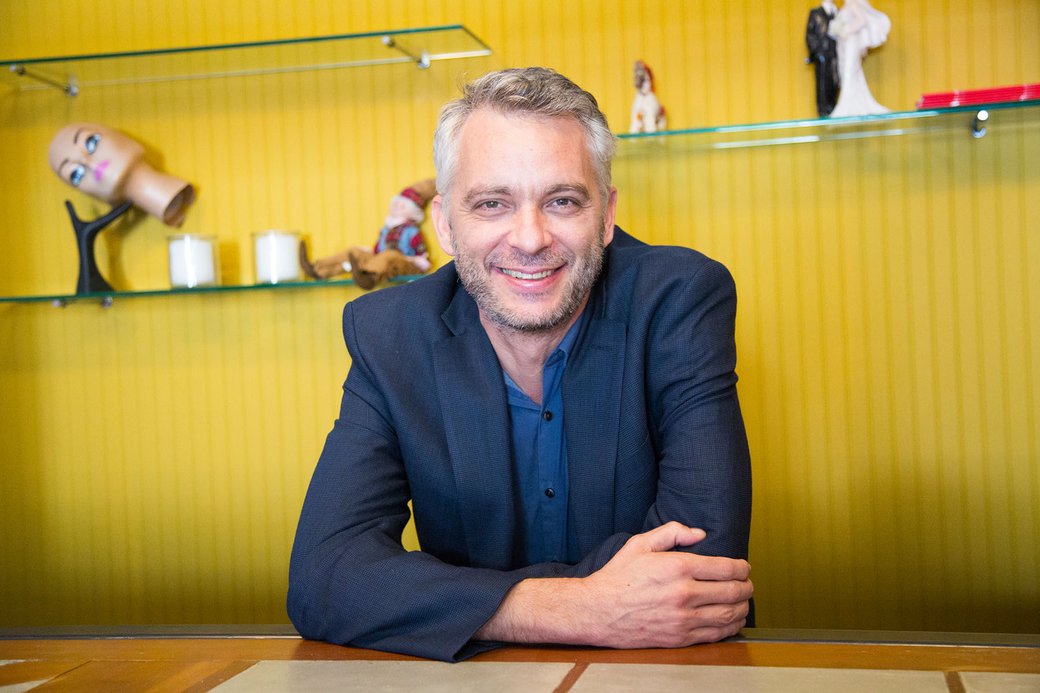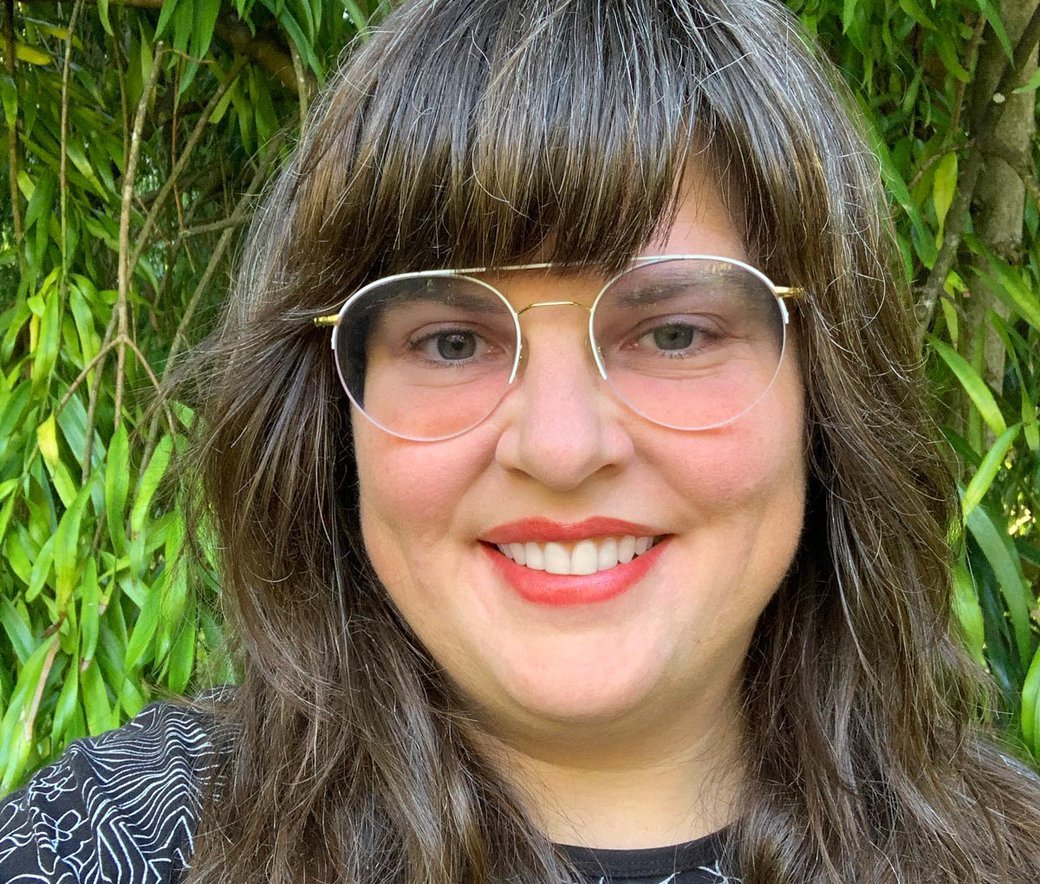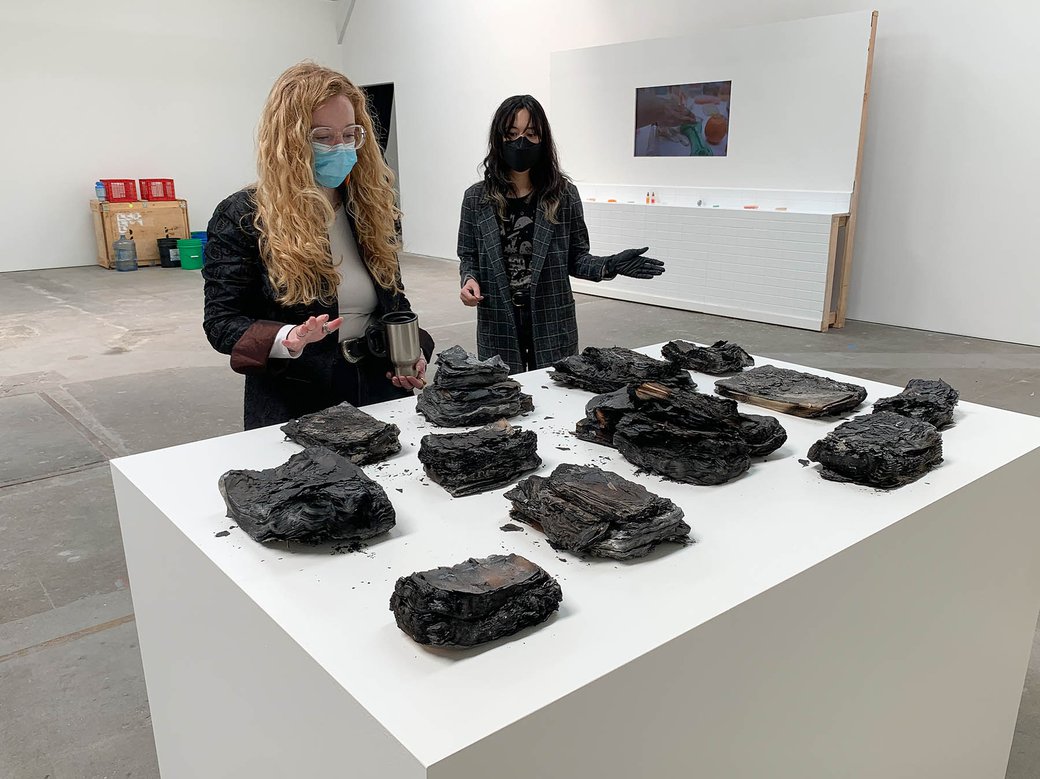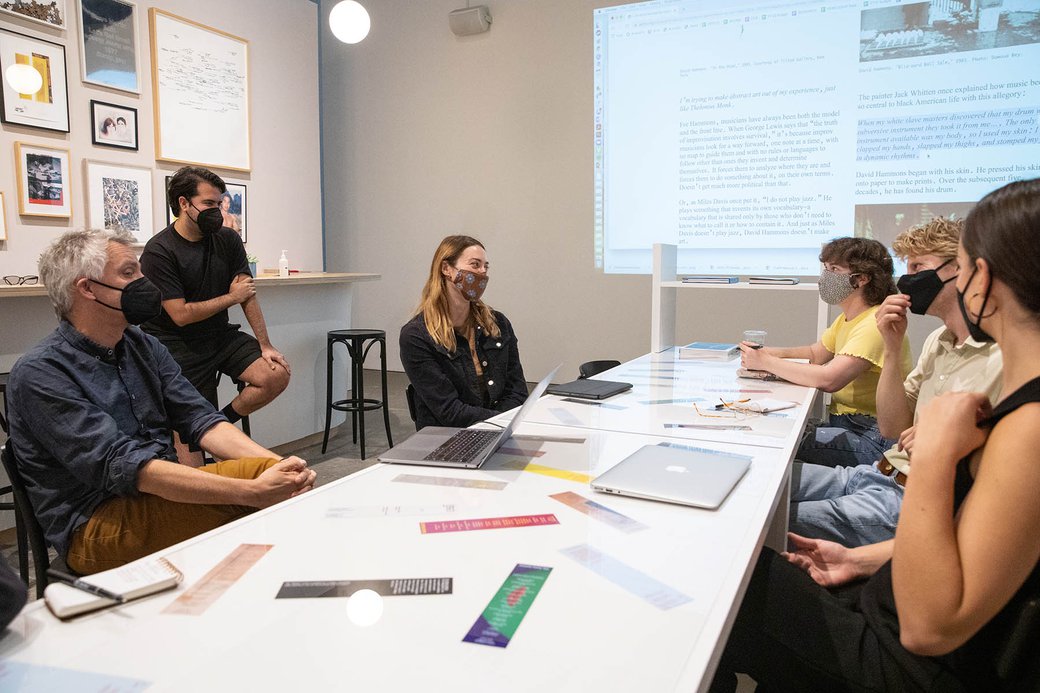
Connecting CCA and the Wattis Institute
Christina Linden and Anthony Huberman discuss the adjacency of the Wattis and CCA—and how they’re working to expand the dialogue between the two.
Since its founding in 1998, the Wattis Institute for Contemporary Arts has been a valuable part of the CCA ecosystem, bringing accomplished contemporary artists, academics, and thought leaders to San Francisco. While connecting with external visitors is a priority for the Wattis Institute, Director and Chief Curator Anthony Huberman has been working to further integrate the Wattis Institute into CCA and its curriculum, engaging with students throughout their time at CCA.
In fall 2021, CCA faculty member Christina Linden joined the Wattis team as its first-ever head of academic engagement with an eye on strengthening the bond between the Wattis Institute and CCA as a whole. Linden recently became chair of Curatorial Practice, which moved from CCA’s Fine Arts division to its new home in Humanities & Sciences under the leadership of Dean TT Takemoto. The Wattis has frequently partnered with CCA’s Curatorial Practice program, providing students with real-life examples of curating and guidance on the logistics of staging an exhibition.
Takemoto recently met with Linden and Huberman to talk about the links between the Wattis and Curatorial Practice program, and the new initiatives they’re working on to engage the entire CCA community with Wattis programs.

Anthony Huberman
TT Takemoto: What brought you each to CCA and the Wattis? And what makes the Wattis and the Curatorial Practice program unique?
Anthony Huberman: What drew me to CCA was the Wattis. It's a rare gem in the American contemporary art institutional landscape. There aren't many places that are able to do what the Wattis is well-positioned to do—it’s not a huge museum, it's also not a commercial or a scrappy artist-run space. It has a robust infrastructure, and most importantly, it's part of CCA’s learning environment, so it contributes to a community that is already very invested in thinking and learning about art and contemporary culture.
Throughout its history, the Wattis has not only been able to attract really great artists, but it has been able to support artists in making new work. They have made something for the Wattis and with the Wattis, and then have gone on to have highly visible and successful careers.
And so in that way, the Wattis taps into the conversations about art and experimental culture that are happening nationally and internationally and creates a bridge that connects them to the conversations happening at CCA.

Christina Linden
Christina Linden: In my new role as the Wattis Institute’s head of academic engagement, I’m excited to continue to think about how the fields of curatorial practice and education can come together. I've been teaching for about 12 years at various colleges and universities—this is my fourth year here teaching full-time in the Curatorial Practice graduate program—and I'm also a curator.
The Wattis is adjacent to the college, and I'm excited to think through how some of the new programs we'll be developing this year can strengthen the connections that are already implicit in that adjacency.
The Curatorial Practice program differentiates itself from museum studies programs by focusing on how curators work with artists and shape contemporary art. The program at CCA has always had a bit of a West Coast, San Francisco appeal. We embrace a broader understanding of what curatorial practice can be, with emphases on fostering collaboration and engaging diverse audiences in order to stay open to change that needs to take place in the field.
TT: Anthony, what’s the relationship between CCA and the Wattis?
AH: The second I got here, one of the main things that I wanted to take advantage of is the close access—the “adjacency,” as Christina put it—to CCA’s artistic and intellectual community. I wanted the Wattis to recognize that by nature of being part of a learning community, it can be so much more than just an exhibition space, so much more than a room where objects are put on display.
Our central mission is to trust, support, and center artists, and we’ve found different kinds of ways to work with artists and support their perspectives. I split the program into two distinct parts to achieve this.
One part is the exhibition program, where we present exhibitions in our galleries, and mostly work with one artist at a time in a series of solo shows that involve producing a new body of work. The exhibition program’s engagement with CCA is ongoing, and that’s something that I know Christina is excited to build on.
The second part is the research program, which takes the form of a year-long “think tank,” or a Wattis Research Institute, where a series of conversations among CCA faculty and Wattis staff revolve around the work of a single artist, which becomes a shared research interest.
So while there is an artist who is “on view” at the Wattis, meaning their work is on display in the galleries, there is another artist who is “on our mind,” meaning their work is not on display but is the focus of in-depth research and collective conversation..
This year, for our eighth research season, the artist Lorraine O'Grady is on our mind. In past years, we've worked with artists like Andrea Fraser, David Hammons, Joan Jonas, and Trinh T. Minh-ha. These are artists who have robust practices, but more importantly, their work touches on a wide range of really rich thematic strands that overlap with many of the interests of the CCA faculty.
The Wattis Research Institute becomes a glue, in a way, connecting Wattis staff to CCA faculty. That's just one of the ways in which the Wattis has tried to create a link with the academic community.

Emily Markert and Leandra Burnett (both MA Curatorial Practice 2021) discuss Jenny Kendler’s Underground Library during the installation of the Curatorial Practice 2021 exhibition, Contact Traces.
TT: What are some of the unique opportunities Curatorial Practice students have with the Wattis?
CL: The Curatorial Practice students have had the benefit of being able to stage their capstone project, their thesis exhibition, at the Wattis Institute.
It's been exciting to be able to bring Wattis staff members into the class to share their own points of view. Anthony has spoken with students about how he develops a concept for an exhibition, sharing his process, and also how that can work differently for different curators and in different institutions.
Wattis curator Kim Nguyen most recently spoke with curatorial practice students about the rupture brought about by events of the past couple of years, the opportunity this might pose for museums and other institutions of contemporary art to shift away from inequity, and the still-existing hurdles that make this kind of action an ongoing challenge.
Diego Villalobos, the Wattis’s exhibitions manager, also helps the students develop their projects step-by-step, demonstrating how one develops a budget or how an installation is planned. And the students talk with other staff members about publications, audience engagement, and programs. It's been great to be able to begin with a concept at the start of the year and get feedback, even from the first month, from a panel that includes the entire Wattis staff as well as faculty and other staff. It helps students think through what's relevant and urgent and how that can take form as an exhibition.
And each year one of the incoming first-year students in the Curatorial Practice program works closely with the Wattis staff as a fellow. It’s a learning opportunity for the students, but I hope it's also been a benefit to the Wattis staff to integrate those new skills and perspectives.
AH: It's been fantastic for us. There have been some really great curatorial students who have become invaluable members of our team.
One of the ways to think about the Wattis is as CCA’s in-house museum, so we can be used as a kind of case study. As Christina said, I might have my way of developing an exhibition, and other curators will work very differently. How is the Wattis program or approach different from or similar to other museums locally or in other parts of the world? It can be a departure point for students to think critically about many possible options.

Curatorial Practice students in Dena Beard’s Art and Experiences class meet with Anthony Huberman and Diego Villalobos to learn about the upcoming Wattis Institute exhibition, Drum Listens to Heart.
TT: What are your plans for engaging with Curatorial Practice and CCA as a whole in the future?
CL: We're looking to extend the existing relationship between Curatorial Practice and the Wattis but also think seriously about how that adjacency between the Wattis and CCA as a whole can be strengthened, and how engagement can help create new opportunities for students.
Dena Beard, the director of The Lab in San Francisco, teaches a course for first-year Curatorial Practice students called Art and Experiences. In September, her class visited the Wattis to hear Anthony and Diego speak about Drum Listens to Heart, a group exhibition that's in development for 2022. It’s exciting to give new students in our graduate program a chance to hear about the ideas that are forming as the exhibition is being developed.
In response to that visit, each of the students is proposing an initiative that will take place while the exhibition is on view. The idea is for these graduate students to think about engaging CCA undergraduate students around the exhibition. I can’t predict what the students will come up with—the initiative could take the form of a video for the Wattis website that faculty can use in their courses, or an assignment designed for studio classes asking students to create a drawing or a zine or a video that responds to the exhibition. Or it could take the form of a guided tour, maybe one of the most tried-and-true forms of museum education, but with a particular theme. This is one way the Curatorial Practice students will learn about the possibilities of engagement through practice, and it is a way that will also bring undergraduate students into the sphere of the Wattis.
AH: What Christina's describing is a great example of how a web starts to be formed between CCA and the Wattis that has lasting power. With Christina as the Wattis’s head of academic engagement, we will be able to weave the college and the Wattis together in a consistent way, rather than focusing on one-off collaborations.
CL: We recently started talking, for example, about what class visits to exhibitions can mean. In a conversation with Erik Scollon from the First Year Core Studio program, we asked, “What are the desired outcomes? What do faculty want? What do students want out of that visit? What can they take away from it?”
We are going to put feedback structures in place for upcoming class visits to answer some of these questions. We’ll reach out to faculty in advance of their visit with targeted information and discussion prompts, and then we’ll also connect after the visit to talk about what the students ended up being interested in, what they discussed, or if those faculty use the visit as a jumping-off point for an assignment. On a very simple level, it will be a different way to start gathering information so that effort and energy and functionality can be optimized around class visits moving forward.
“I hope that CCA students find themselves at the Wattis more often, that it becomes a gathering place.”
Wattis Institute Director and Chief Curator
TT: This is the first year we have a robust residential community on campus—we have almost 500 students living in the dorms. Just the idea that the Wattis will be part of their CCA experience from their very first year at CCA is exciting. What are you hoping students will take away from their time at CCA, in such close proximity to the Wattis?
AH: On a basic level, I would hope that upon graduating from CCA, students would say that their interactions with the Wattis Institute formed an important part of what they learned about contemporary art and ideas while they were at CCA. That they were able to recognize and take advantage of the resources the Wattis provides CCA, and that they graduated having gotten something from their interactions with the exhibitions, the lectures, the collaborations.
And I hope that they find themselves at the Wattis more often, that it becomes a gathering place. If you have enrolled in an art school, you are invested in the question of what art looks like and what it means right now, and so the Wattis will be a place of interest since everything we do is engaged with that question and we provide an important point of contact between the academic community and the Bay Area's cultural and artistic community at large. The Wattis can be a place that they know they can turn to. If they go to a lecture or attend a workshop, they know that there's going to be a community of people who share interests in common.
CL: Part of that process of finding out what engagement looks like and means for CCA and the Wattis is to ask questions that might sound basic, like, “Who is coming to the Wattis? How comfortable do they feel? What are their interests, in their own artistic practices and in their lives? How can meaningful conversations develop between those interests and the programs and exhibitions at the Wattis? How can that be an exchange rather than a one-way communication?”
Part of the intention with the creation of my role within the Wattis Institute is to think about how that dialogue can be expanded, and how we can take very seriously the questions of what the CCA community brings to the table and how that community can be more and more inclusive.